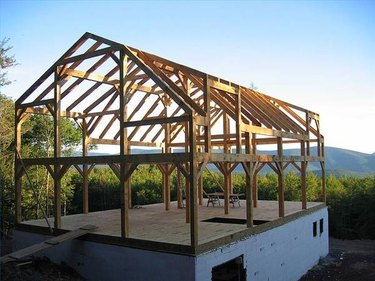
Post and lintel construction is created by setting a horizontal beam on top of two vertical supports. This simple design, which is also known as post and beam, can be found in doorways, windows and the framework of many buildings. It supports a large amount of weight, thus allowing buildings to rise higher than one story and broadening doorways and windows. There are many variations to the post and lintel design, with crossbeams, arches and walls added for extra support or as design elements.
Features of Post and Lintel Construction
Video of the Day
Post and lintel construction is recognized by its simple vertical and horizontal design, in which a pair of vertical supports are set in the ground or a foundation, and a horizontal structure is balanced on top of them. To find a good example of post and lintel construction, look no further than a doorway, which features thise type of construction. This method has been used not only to for openings but also for framework.
Video of the Day
Lintel refers to the horizontal beam that goes across two supports. Although it is often referred to as a beam, a lintel can take many forms, such as a block of stone or metal reinforcement. A lintel is designed primarily to hold weight, such as a roof or deck, depending on the vertical posts it rests on. It can support a huge amount of weight, and is effective for reinforcing tall buildings or heavy structures. The post refers to the vertical support, which is paired with an identical support to form the full design. Posts can be columns, poles or beams, modified to meet as architectural designs.
History of Post and Lintel Construction
One of the earliest and most renowned post and lintel example is the prehistoric Stonehenge monument in England, where massive stone blocks were placed in a circle in the support-and-overhead design. Pure post and lintel construction also can be found in a variety of early shelters, including huts, cottages and stables.
The Romans developed a variation of post and lintel construction with the arch, which added stability and support, and by the Catholic Church in Europe with the introduction of buttresses to support massive cathedral walls.
Modern Post and Lintel Construction
Today, most post and lintel construction has a third component, the wall, which adds additional support and hides the post and lintel design within the framework. It can still be seen in doorways and columns, in which the space between the vertical supports is open. Variations on post and lintel design can be found in bridges, complex archways and crossbeams, sometimes with cable support adding extra stability. Because post and lintel construction is so simple, it forms the base for the entrances to modern buildings that do not feature curves, which add stability.
Post and lintel construction today can incorporate wood, metal and stone. When used in doorways, wood and steel are the most common materials. Depending on building requirements and ordinances, the supports in windows may be made of plastic or fiberglass, while wood or metal form the surrounding frame.
The most important detail about post and lintel construction is the pieces must fit together exactly, so they are often prefabricated in mills and shops, and then assembled on-site. This is an excellent way to ensure quality control in the construction process.